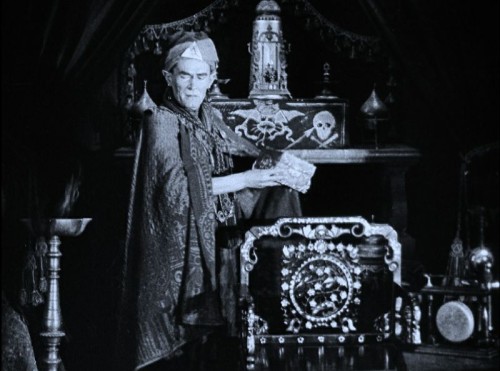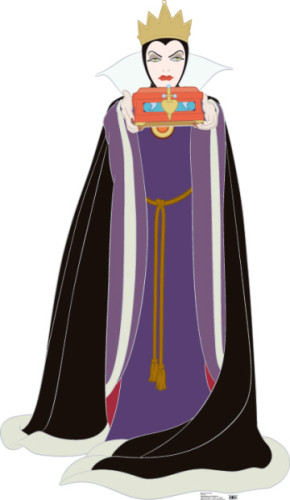I am starting this journey in the early days of American cinema; from its inception in 1895 through its development into a viable culturally-influential industry. I’ve dated this period as “pre-1939.” Many of you will recognize 1939 as being the release date of Metro Goldwyn Mayer (MGM)’s classic film The Wizard of Oz, a film that contains the most iconic Hollywood witch in American cultural history.
From 1895 to 1916 moving pictures were just a technical novelty. As film historian Jeanine Basinger said, “No one really took movies very seriously. It was thought that they were a fad.” Most early movies depicted actual events, landscape photography, historical re-enactments or popular stories. (Basinger, American Cinema, 1994)
During these first two decades, only nine American films contained a witch. Of these nine, five were dramatizations of beloved fantasy stories. The list includes The Magic Sword (1901), The Wonderful Wizard of Oz (1910), His Majesty the Scarecrow (1914), Mary PIckford in Cinderella (1914), and Snow White (1916).
In all of these films, the witch is a non-threatening, non-theological fairy tale construct. Her appearance and behavior recall the circus-clown or court jester with a big round collar and colorful patchwork clothing, or a heavy wizard cape and cone hat. She plays the role of the buffoon.

William Wenslow’s Wicked Witch from the original printing of The Wonderful Wizard of Oz
Because this is the silent film era, filmmakers primarily used visual cues to define character. To do so, they had to draw from pre-cinematic cultural sources in order to speak to their viewers. The witch as clown motif can be found in still renderings from that time period. It is even a common element in Mother Goose drawings. Additionally, all of these stooped, elderly witches are surrounded by other non-cinematic icons such as brooms, cauldrons, and pointed hats.
The concept of magic focuses on transformation and trickery. For example, In His Majesty the Scarecrow (1914), Mombi the Witch transforms her three ugly companions into beautiful maidens. In Snow White (1916), the witch transforms the Queen from bland to beautiful. The use of magic in this way is reminiscent of something you might find in a Shakespearean comedy of mistaken identity (e.g. As You Like It)
Of the earliest nine films, the remaining four did not recreate fantasy stories. However, they have very little influence on the construction of the Hollywood witch. These include a lost animated experimental short called Bewitched Matches (1913). The first filming of Shakespeare’s MacBeth (1916) and an historical narrative called The Witch of Salem (1913).
The fourth film, The Mysteries of Myra (1915), is the most interesting of these early witch movies. The popular seventeen part film serial recounts the tale of Myra Maynard, the daughter of an Occult leader, who is repeatedly hunted by her dead father’s devil-worshipping Order. In each episode, the narrative tackles an Occult subject with no mention of witchcraft until episode thirteen. In this aptly numbered episode, a cloaked witch helps Myra escape the satanic Order.
Film restoration artist Eric Stedman, notes that episode thirteen is the only one to “introduce traditional fantasy – magic and characters rather than concepts derived from then – current spiritualism.” What spiritualism? He is referring to the public’s growing interest in Occult practice and, of course, Aleister Crowley. Some of the film’s Occult imagery recalls the popular images of Crowley himself. Interestingly, at the time of filming, Crowley was living in New England not terribly far from the production lots in Ithaca, NY. .

Shot from one of the Occult scenes from The Mysteries of Myra (1915)
Despite the narrative proximity of witchcraft and Satanism in the serial, the writers clearly separated the two magical practices. In this way, the witch remained a fantasy construction. At some point in the pre-cinematic entertainment world, the witch was separated from her satanic connection and became trapped within a fairy tale. As such, she is denied all theological relevance or esoteric meaning – good or bad. Although it is outside my exploration, I would speculate that this is the result of Victorian cultural styling and the increasing dominance of rational thought.
Now, let’s move to the period ranging from 1916 to 1932. During these sixteen years, there is only one Witch film – a lost animated short called At Rainbow’s End (1925). Why did the witch disappear? At this time movies had transitioned from novelty to commodity. The new industry, now located in California, had to maintain viewer interest through realistic sensationalized marketing strategies. Remember, this is before the Production Code. The fantasy witch had no place in salacious, adult entertainment and, therefore, disappeared. (Eric Smoodin, Animating Culture, 1993)
However, by 1932, the world and Hollywood had drastically changed. Silent films turned to sound (Talkies) and the Hayes Commission began enforcing its Catholic-based moral censorship code. Additionally, the country had lived through a World War, the free-wheeling roaring 1920s and was now in a deep economic depression. Hollywood responded with wholesome, upbeat and glittery escapist films. Not surprisingly the fantasy witch reappears. From 1932-1939, Hollywood produced five witch films including Disney’s Babes in the Woods (1932), Betty Boop’s Snow White (1933), Betty Boop’s Baby Be Good (1935), The Greedy Humpty Dumpty (1937) and Disney’s Snow White (1937).
At first glance, these animated witches appear to be similar to the earlier variety. They are “hags in rags” with cauldrons, brooms and pointy hats. However, there is a difference. In Disney’s Babes in the Woods (1932), the witch plays the buffoon, but she is more grotesque in form. Her pointy face and emaciated body are gangly and sharply angled. Her clothes, now dark and ragged, are topped with a flowing torn cape. This iconic look is repeated over and over throughout the period.

Walt Disney’s Wicked Queen from Snow White and the Seven Dwarfs (1937)
Then in 1937 Disney released what would become his masterpiece – the first full-length animated feature film, Snow White and the Seven Dwarfs. In its wake, the film created a famous American Hollywood witch – the Wicked Queen. She is the first witch to step out of the side-show act and enter the realm of macabre. Disney’s Queen is an amalgam of the early fairy tale witch, the 1930s animated hag and something new, something darker. While she is still trapped within the fairy tale narrative, she is frightening and intense in both her forms: “a hag in rags” and glamorous queen.
In addition, for the first time in Hollywood’s history, we witness the witch as a representative of “transgressive female sexuality.” Film professor Elizabeth Bell notes that Disney’s production papers describe the Queen’s “beauty as sinister, mature [with] plenty of curves.” The Wicked Queen is a femme fatale who is defined as “represent[ing] demonic natural forces that, like a cyclone, threaten to uproot man from himself.” In this historic film, the Hollywood witch transmutes into what feminist film theorist Barbara Creed calls “the monstrous feminine.” (Elizabeth Bell, “Somatexts at the Disney Shop,” From Mouse to Mermaid, 1995)
During the Pre-1939 period, the witch began her journey as a side-show act devoid of any esoteric or theological meaning. By the end, she had transformed into an allegory for the powerful, independent, sexualized woman. Was this a function of America’s need to reinforce traditional gender roles during the Depression? Or was it simply a function of Disney’s own conservative nature?
In the next post, we’ll move on and follow the transformation. Next stop, the year 1939 with the release of The Wizard of Oz and the birth of the all-American Hollywood Witch….
The Wild Hunt is not responsible for links to external content.
To join a conversation on this post:
Visit our The Wild Hunt subreddit! Point your favorite browser to https://www.reddit.com/r/The_Wild_Hunt_News/, then click “JOIN”. Make sure to click the bell, too, to be notified of new articles posted to our subreddit.

I would suggest that the sexualization of the (female) witch in the late 1930s was part of the continuing struggle for expression of verboten topics around the edges of the Code. Of course it reflects the gender stereotypes of the day.
Great observation about the codified film language. If the Code was trying to make expressed sexuality bad, than making a bad witch sexy only serves to reinforce the idea.
sort-of-OT: Witch hunters in Africa are also Homo-hunters…go figure…
http://www.publiceye.org/publications/globalizing-the-culture-wars/
Great article! I love witch cinema but no almost nothing about this early era of film. What I have always found interesting is that people often describe the Wicked Queen as “turning into a witch” when she disguises herself.
Very interesting distinction that there is no infernal connection for any of these witches. Looking forward to the rest of this series.